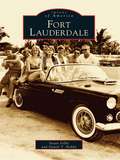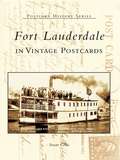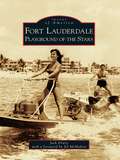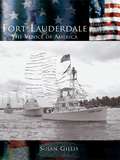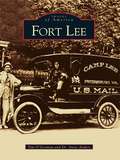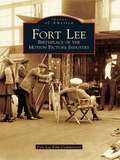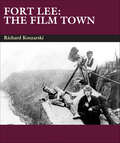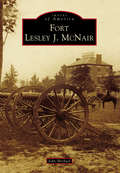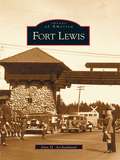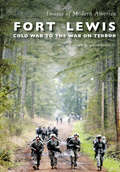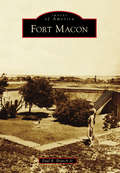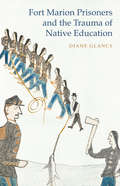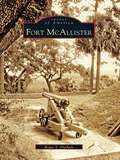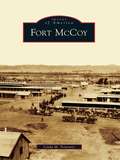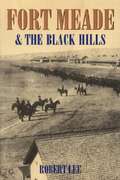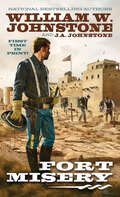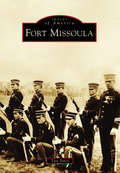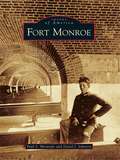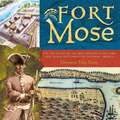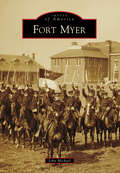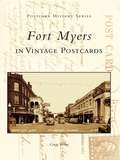- Table View
- List View
Fort Laramie: Military Bastion of the High Plains
by Douglas C. McchristianMcChristian (author and retired historian, National Park Service) provides a complete military history of Fort Laramie, one of America's most venerated historic places. The book details every stage of the fort's existence, from its beginnings in 1834 as a trading post, its involvement in the buffalo hide trade, overland migrations, Indian wars and treaties, the Utah War, and into the telegraph and first transcontinental railroad eras. It also includes previously untold stories, such as the 1874 murder of Lieutenant Levi Robinson. The book also includes photographs of the fort, its surroundings, and the personalities who were involved with it. Annotation ©2009 Book News, Inc., Portland, OR (booknews.com)
Fort Lauderdale
by Susan Gillis Daniel T. HobbyLike many Sun Belt cities, Fort Lauderdale has experienced phenomenal growth over the past several decades. Once a wilderness home for the Seminole Indians and a few hardy pioneers, the small community grew up around Frank Stranahan's successful trading post, a convenient stop for hunters, fishermen, and sightseers preparing to head into the Everglades. But much more was in store for this rugged outback camp. Surveying Fort Lauderdale's fascinating history chronologically, this pictorial retrospective begins with the 1890s, a time when this part of the country was still part of America's frontier, isolated and wild. With the coming of the railroad and the twentieth century, an agricultural economy developed, and, soon, the Florida land boom would bring thousands of new settlers to the area. Fort Lauderdale's glistening beaches and comfortable climate earned the city anearly reputation as a tourist town and, eventually, as a Spring Break mecca.
Fort Lauderdale in Vintage Postcards
by Susan GillisFort Lauderdale, Florida, is a well-known tourist destination whose very name evokes the image of a postcard. What is today one of Florida's largest cities was not always prized for its beautiful beaches and tropical climate. In the early 20th century, it was hailed as the "Gateway to the Everglades" and a "vegetable shipping capital." By the 1920s, Fort Lauderdale found itself at the very center of the phenomenal Florida land boom. Development and tourism became driving forces for the new economy-and there has been no looking back.
Fort Lauderdale: Playground of the Stars
by Ed Mcmahon Jack DruryFew Southern cities have stronger claims to fame than Fort Lauderdale. As one of the great vacation destinations in America, over the years it attracted such celebrities as Bob Hope, Jayne Mansfield, Johnny Carson, Cary Grant, and the worldchampion New York Yankees. This beach townâ TMs history is starstudded and rich with interesting stories and photographs from that period.
Fort Lauderdale: The Venice of America
by Susan GillisTaking its name from a fortification established more than 160 years ago during the Second Seminole War, Fort Lauderdale boasts a history stretching back 5,000 years before the first white settlers arrived in the eighteenth century. From beautiful tales of the "mysterious" New River that helped launch the community to more recent stories of rum running and gambling, segregation and integration, and boom and bust, the history of this Florida city is told here through the everyday lives of those who lived it.
Fort Lee (Images of America)
by Tim O’gorman Dr Steve AndersFort Lee, located adjacent to the Petersburg Civil War Battlefield, is the designated Home of the United States Army Quartermaster Corps. The first Camp Lee, established as a National Army Cantonment in 1917, trained the 80th Division for service in France. In 1940, Camp Lee was reestablished, and since World War II, has trained hundreds of thousands of Quartermasters, whose numerous skills include military supply, water and petroleum operations, Army field feeding, and parachute rigging for "supply by sky." Fort Lee is also the home of the Defense Commissary Agency and the Army Logistics Management College, which provides advanced schooling for Armed Forces logisticians. For over 60 years, Fort Lee has played a vital role ensuring that America's Army is the best-equipped and most well-supported army in the world.
Fort Lee: Birthplace of the Motion Picture Industry
by Fort Lee Film CommissionA favorite locale of such film pioneers as D. W. Griffith and Mary Pickford, the historic borough of Fort Lee was the first center of the American motion picture industry. Studios lined both sides of Main Street, and enormous film laboratories fed the nickelodeon market with thousands of reels of comedies and cliffhangers. Broadway stars and producers came here to make many of their first feature-length films; but by the 1920s, Theda Bara, Fatty Arbuckle, and Douglas Fairbanks were gone. Yet even after the studios closed down, the film industry was still the backbone of the local economy, with hundreds working behind the scenes in the printing, storage, and distribution of movies being made in Hollywood.
Fort Lee: The Film Town (1904-2004)
by Richard KoszarskiDuring the 1910s, motion pictures came to dominate every aspect of life in the suburban New Jersey community of Fort Lee. During the nickelodeon era, D.W. Griffith, Mary Pickford, and Mack Sennett would ferry entire acting companies across the Hudson to pose against the Palisades. Theda Bara, "Fatty" Arbuckle, and Douglas Fairbanks worked in the rows of great greenhouse studios that sprang up in Fort Lee and the neighboring communities. Tax revenues from studios and laboratories swelled municipal coffers.Then, suddenly, everything changed. Fort Lee, the film town once hailed as the birthplace of the American motion picture industry, was now the industry's official ghost town. Stages once filled to capacity by Paramount and Universal were leased by independent producers or used as paint shops by scenic artists from Broadway. Most of Fort Lee's film history eventually burned away, one studio at a time.Richard Koszarski re-creates the rise and fall of Fort Lee filmmaking in a remarkable collage of period news accounts, memoirs, municipal records, previously unpublished memos and correspondence, and dozens of rare posters and photographs—not just film history, but a unique account of what happened to one New Jersey town hopelessly enthralled by the movies.Distributed for John Libbey Publishing
Fort Lesley J. McNair (Images of America)
by John MichaelFrom southeast Washington, DC, where the Potomac and Anacostia Rivers meet, this fort has continued to protect America's capital. In 1791, Pierre L'Enfant designated it as a military reservation. The post is the third oldest in continuous operation--as an arsenal, a penitentiary, a hospital, and now, a military education center. It was renamed in 1948 to honor Lt. Gen. Lesley J. McNair, who was killed in World War II. Over the course of two centuries, the fort has born witness to the British ransacking during the War of 1812; a Civil War explosion that killed female arsenal workers; and the incarceration, trial, and hanging of Lincoln assassination conspirators. Over time, it became the home of several artillery commands, the first federal penitentiary, the US Army Engineer School, the US Army Music School, the US Army War College, and the US Army Band ("Pershing's Own"). Today, it has evolved into the National Defense University, Inter-American Defense College, and the headquarters of the Military District of Washington.
Fort Lewis: Cold War To The War On Terror (Images of America)
by Alan H. ArchambaultThe area now known as Fort Lewis was first recognized for its potential as a military reservation in the early 1900s when a series of militia and national guard encampments were held in the area. Camp Lewis was established as the United States entered World War I in 1917 and became the first Army installation in the history of the nation to be created as a direct result of the outright gift of land by private citizens. During World War I, Camp Lewis became the largest military post of the era. Here, thousands of "doughboys" trained for the Great War and began a tradition of training excellence that continues to this day. In 1927, the camp was designated a permanent post and offically became Fort Lewis.The story of this important military installation is told here in a series of historic photographs, from the collections of Fort Lewis Military Museum dating from the early 20th century to the present. The photographs capture not only the natural beauty of the area and prominent buildings, but also many of the men and women who have served their nation at Fort Lewis.
Fort Lewis: Cold War to the War on Terror (Images of Modern America)
by Alan H. ArchambaultCamp Lewis was established in 1917 as a training camp for the US Army in World War I. Made a permanent post in 1927, Fort Lewis became an important base for training and sending soldiers to combat in World War II and the Korean War. In 1956, the 4th Infantry Division arrived at Fort Lewis while America was deeply committed to protecting democracy around the world during the Cold War. From that time forward, Fort Lewis has been in the forefront of military reservations in the United States. The post played a crucial role in the Vietnam War, Operations Desert Shield and Desert Storm, and the War on Terror. Soldiers based at Fort Lewis have deployed to conflicts throughout the world in defense of freedom. Today, Fort Lewis remains on the cutting edge of America's sword.
Fort Macon
by Paul R. BranchSilently standing guard on the eastern point of Bogue Banks overlooking the entrance to Beaufort Harbor, Fort Macon is the centerpiece of one of the most visited North Carolina State Parks. Since Fort Macon State Park was established in 1924, it has been a familiar destination for millions of visitors to the "Crystal Coast" of Carteret County, North Carolina. The old historic fort itself, standing today in venerable repose, harkens back to another time in our country's history, however. At different times throughout its long, storied past, the fort has served as a US Army garrison post, a stronghold occupied for defense in three different wars, the scene of a desperate battle, a prison, and finally the second oldest state park in North Carolina. Fort Macon showcases this unique coastal fortification through historic images, highlighting not only its military past, but its role as a popular tourism destination through the years.
Fort Marion Prisoners and the Trauma of Native Education
by Diane GlancyAt the end of the Southern Plains Indian wars in 1875, the War Department shipped seventy-two Kiowa, Cheyenne, Arapaho, Comanche, and Caddo prisoners from Fort Sill, Oklahoma, to Fort Marion in St. Augustine, Florida. These most resistant Native people, referred to as “trouble causers,” arrived to curious, boisterous crowds eager to see the Indian warriors they knew only from imagination. Fort Marion Prisoners and the Trauma of Native Education is an evocative work of creative nonfiction, weaving together history, oral traditions, and personal experience to tell the story of these Indian prisoners.Resurrecting the voices and experiences of the prisoners who underwent a painful regimen of assimilation, Diane Glancy’s work is part history, part documentation of personal accounts, and a search for imaginative openings into the lives of the prisoners who left few of their own records other than carvings in their cellblocks and the famous ledger books. They learned English, mathematics, geography, civics, and penmanship with the knowledge that acquiring the same education as those in the U.S. government would be their best tool for petitioning for freedom. Glancy reveals stories of survival and an intimate understanding of the Fort Marion prisoners’ predicament.
Fort Martin Scott: Guardian of the Treaty (Landmarks)
by Joseph LutherFort Martin Scott still stands guard in the heart of Texas 150 years after its construction, which was prompted by a peace treaty between Germans and the Penateka Comanches. The first frontier fort in Texas, the original complex of twenty-one buildings allowed soldiers to patrol the Upper Immigrant Trail through Comanche and Apache territory. The old fort was a hub for military patrols during the Texas Indian Wars. Famous army units, including the First and Eighth Infantries, as well as the Second Dragoons and Fourth Cavalry, were all stationed at this post at one time or another. Fort Martin Scott was the locality of much partisan conflict during the Civil War. Author and historian Joseph Luther tells the full story of this historic Texas icon.
Fort McAllister: Fort Mcallister, Georgia, In The Civil War And Beyond (Images of America)
by Roger S. DurhamMany earthen fortifications defended the city of Savannah and its numerous water approaches after the Civil War broke out. One of these defenses, Fort McAllister, protected the entrance to the Ogeechee River and the strategic railroad and highway bridges upstream. From November 1862 to March 1863 the U.S. Navy bombarded the fort seven different times without success. The fort finally fell to General Sherman in December 1864; ironically, the final threat the fort faced was not from an enemy trying to get up the river, but from one trying to get down the river to the sea. In the 1920s auto magnate Henry Ford renovated the fort and focused new attention on its history.
Fort McCoy (Images of America)
by Linda M. FournierFrom the days of the horse-drawn caisson to today's Humvee, Fort McCoy has played a vital role in the military readiness of America's armed forces. The only federal military installation within the state of Wisconsin, Fort McCoy has seen more than five million military personnel from throughout the UnitedStates pass through its gates since its founding in 1909. Fort McCoy exists today primarily because its founder, Maj. Gen. Robert B. McCoy, foresaw that the U.S. Army would need a regional site at which to train and maneuver and then dedicated himself to making that vision a reality. Fort McCoy's mission ofsupporting training and mobilization has remained constant from those early days on the McCoy ranch to the current global War on Terror. This book chronicles the illustrious history of Fort McCoy from the doughboys of World War I to today's soldiers supporting Operations Enduring Freedom and Iraqi Freedom.
Fort Meade and the Black Hills
by Robert LeeFort Meade was the home of the famous Seventh Cavalry after its ignominious defeat in the Battle of the Little Bighorn. Troops from Fort Meade played a pivotal role in the events that led to the tragedy at Wounded Knee in 1890. It was the scene of imprisonment of Ute Indians who made the mistake of interpreting their new citizenship status as freedom from government control. The fort survived the mechanization of the horse cavalry, aided the record-breaking Stratosphere Balloon flight of 1935, and became a training site for the nation's first airborne troops. Fort Meade existed for sixty-six years, from 1878 to 1944. Robert Lee examines the strategic importance of its location on the northern edge of the Black Hills and the role it played in the settlement of the region, as well as the role played by the citizens of Sturgis in keeping it alive. One of the chief delights of Fort Meade and the Black Hills is a gallery of characters including the unfortunate Major Marcus Reno, the beautiful and fatal Ella Sturgis, and the cigar-smoking Poker Alice Tubbs. They, and events scaled to their larger-than-life size, are part of this long overdue story of Fort Meade. Robert Lee has published several books and many articles on South Dakota's history. Inducted into the South Dakota Hall of Fame in 1987, he was named its writer of the year in 1992.
Fort Miles (Images of America)
by Lee Jennings Dr Gary WrayFort Miles is in Cape Henlopen State Park near historic Lewes and the site of Delaware's first Dutch settlement. Named for Gen. Nelson Appleton Miles, this powerful seacoast fortification was built during World War II to defend the vital industries of the Delaware Valley. Included in this volume are rare vintage photographs of the fort's heavy artillery, hundreds of 3,000-pound sea mines, and radar systems that searched the nearby ocean for the enemy surface fleet. Its powerful 12- and 16-inch guns could reach out between 15 and 25 miles to attack an adversary. Today, the fort is being reborn as one of the best World War II museums in the country; it is housed in a real World War II bunker and includes the barracks complex and fire control towers.
Fort Mill (Images of America)
by Leanne Burnett MorseMore than 250 years ago, near the border where the Carolina colony was divided into north and south, Catawba Indians welcomed the first white settlers to the riverbank at the Nation Ford, and the seeds of a town were sown. Since that time, the area that would become Fort Mill Township has persevered and prospered. From its early days, when Scots-Irish immigrants built the gristmill that gave the town its name, to the explosive growth of the 21st century, the story of Fort Mill has been written by larger-than-life characters like Col. Elliott White Springs, heroic Medal of Honor recipients, resilient cotton farmers, dedicated educators, determined civil rights advocates, and proud mill workers. Fort Mill has set itself apart as a place with a distinct personality and an enduring legacy. Self-sufficiency, Southern grit, and small-town values are just a few of the distinguishing characteristics of this unique town.
Fort Misery (Fort Misery #1)
by William W. Johnstone J.A. JohnstoneLegendary national bestselling Western authors William W. Johnstone and J.A. Johnstone begin a new series with the worst men in the west serving in the US Army with Fort Misery.The baddest men in the West battle for their lives against a relentless band of bloodthirsty prairie rats in Fort Misery—first in an electrifying new Western series from National Bestselling Authors William W. Johnstone and J.A. Johnstone. JOHNSTONE COUNTRY. WHERE THE LAND IS UNTAMED—AND SO ARE THE DESPERADOS. Captain Peter Joseph Kellerman was once a promising career soldier who&’d proven his mettle in battle time and again. Now he&’s fighting a battle with a whiskey bottle. He&’s also in charge of Fort Benjamin Grierson, located west of hell, deep in Arizona Territory&’s Mohawk Valley on the arid edge of the Yuma desert. The men under his command aren&’t fit to wear the uniform. Killers, thieves, and ravagers condemned to death but who&’ve chosen to serve, holding down the hated Fort Misery. Santiago Lozado, the most wanted bandit on both sides of the border, has set his sights on Fort Misery. He wants vengeance against Kellerman for killing his son and has raised an army of brutal Apaches and Comancheros to slaughter every man wearing Union blue—only to encounter a wild bunch of desperate men unafraid of shedding blood and fighting to the death . . . Live Free. Read Hard.
Fort Missoula (Images of America)
by Tate JonesBorn of perceived military necessity and local economic boosterism, "the beautiful little post on the Bitterroot" provided a home for the US Army in Montana from 1877 onward. Called into service almost by accident for the 1877 Nez Perce War, Fort Missoula hosted African American Buffalo Soldiers, aviation pioneers, early military automobile mechanics, Civilian Conservation Corps workers, World War II Italian and Japanese national internees, US military prisoners, and a variety of US Army and Navy units. The base bequeathed to its community a level of sophistication and a connection to the national story unique to the American West. Fort Missoula's architectural legacy also reflects the nation's journey from frontier settlement to world power as an assortment of log structures evolved into "the Million Dollar Post."
Fort Monroe (Images of America)
by David Jeffrey Johnson Paul MorandoFort Monroe was once a powerful symbol of America's national defense system. From 1823 to 1945, its primary military mission was to protect Hampton Roads and the entrance to the Chesapeake Bay from enemy attacks. Over the years, as military technology advanced, Fort Monroe's defensive posture changed. To counter potential threats, American coastal defense installations such as Fort Monroe developed sophisticated steel disappearing guns, mortars, anti-aircraft weapons, and submarine mines. As the site of the army's Coast Artillery School, Fort Monroe trained thousands of soldiers. After World War II, Fort Monroe's role as a coastal defense installation ended, and the post took on new missions as a training headquarters facility. With more than 200 original photographs, this volume unveils the layered history of this massive stone-and-brick installation from the end of the Civil War to the present. This volume will highlight more than 140 years of images that capture Fort Monroe's varied missions, historic buildings, the families who lived there, the resort hotels, and other aspects of this unique national landmark.
Fort Mosé: And the Story of the Man Who Built the First Free Black Settlement in Colonial America
by Glennette Tilley TurnerIn this one-of-a-kind historical picture book, author Glennette Tilley Turner tells the story of Fort Mose, which was founded in St. Augustine, Florida, and was the first free African settlement to legally exist in what later became the United States. Fort Mose was not only the first free black settlement, but it was also the most southern link of the Underground Railroad as a haven of refuge, just as cities in Canada were the northern most link Beginning with the story of Francisco Menendez, the Captain of the Black Militia of St. Augustine, FORT MOSE follows the history of slavery from West Africa to America, recounts what daily life was like, and describes the founding of the Spanish colony's Fort Mose. Established in 1738, Fort Mose gave sanctuary to escaped Africans, challenging slavery in the English colonies. Approximately one hundred Africans lived together, creating a frontier community that drew on a range of African backgrounds, blending them with those of Spanish, Native American, and English people and cultural traditions.
Fort Myer (Images of America)
by John MichaelOverlooking Washington, DC, Fort Myer holds a commanding view of America's capital. Built in 1863 from the Custis-Lee estate, one of 70 defensive Civil War fortifications of the capital, this historic US Army post was known as Fort Whipple. As the war ended and reconciliation began, only this fort remained and was later renamed to honor the US Army's first signal officer, Brig. Gen. Albert J. Myer. These acres of Arlington Heights are distinguished by unique events, including the beginnings of military aviation, the Army Cavalry showcase, "The Three Sisters," and the National Weather Bureau. During World War I, Army officers trained here to fight "Over there," and today two units call Fort Myer home: the Army Band ("Pershing's Own," since 1942) and the 3rd Infantry ("The Old Guard," since 1948). Photographs and text present the evolution of this national landmark in its first 100 years, including its buildings, people, and events.
Fort Myers in Vintage Postcards (Postcard History)
by Gregg TurnerFort Myers lies on the beautiful, wide Caloosahatchee River. Tropical flowers and palm trees dot the landscape, which today boasts a revitalized downtown, historic neighborhoods, shopping, and a breathtaking waterfront. The fort itself, named for Lt. Col. Abraham Myers, was established to quell uprisings and help the Indian Removal campaigns. It was later used by Union forces in the Civil War, abandoned, and then reoccupied by courageous settlers who relied on the cattle business and farming to sustain families and the community. In the late 1800s, Fort Myers began to attract famous winter residents, such as "electrician" Thomas Edison, as well as wealthy sportsmen trying their luck at tarpon fishing. When the "iron horse" finally arrived in 1904, Fort Myers experienced an economic transformation, and her days as a frontier cow town were numbered.

